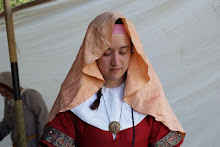
One thing that strikes me again and again is how much obvious recycling of materials you find on the Silk Road. Parchments were folded to make grave-shoes, leftover bits of silk were tacked onto existing garments, embroideries were folded and turned into bags, then unfolded and cut out to make dress yokes. This is one of my favorite examples of this:
Female Dancer: Turfan under the Tang Dynasty, 689 or 633; Wood, silk, clay, and paper; H. 30 cm.
Description: "With her hair piled up high and her face immaculately made-up, this delicate dancer was also excavated from the joint tomb of Zhang Xiong and Lady Qu. Her outfit reflects Central Asian influence: a fine yellow shawl over a striped dress with a blouse featuring two pearl roundels. The high-fired delicate features of the figure suggested tot he excavating archaeologists that she had been made in a major metropolitan center, and they were delighted when they discovered that her arms were made from cancelled pawn tickets from the Tang capital of Chang'an. In addition to the pawnshop documents, archaeologists recovered slips documenting over six hundred small loans that ordinary urban dwellers made to purchase medicine, clothing, beans, and wheat bran."
Source: Li Jian (ed.). The Glory of the Silk Road: Art from Ancient China. The Dayton Art Institute, 2003. P.99

No comments:
Post a Comment